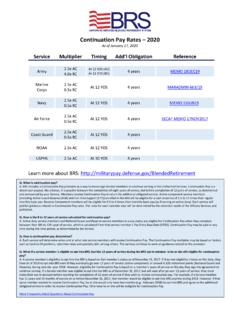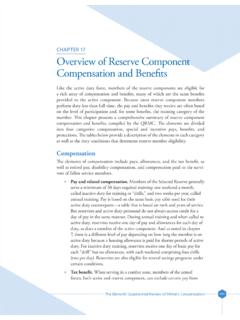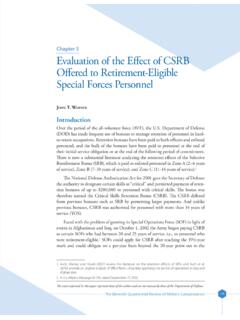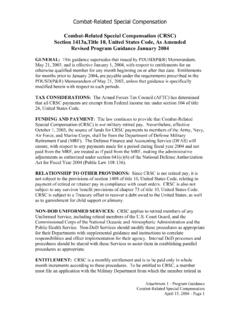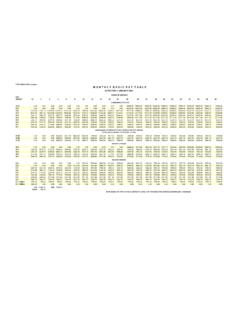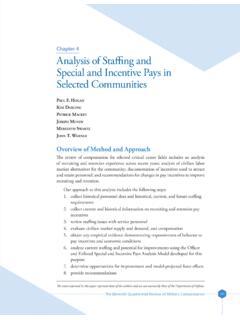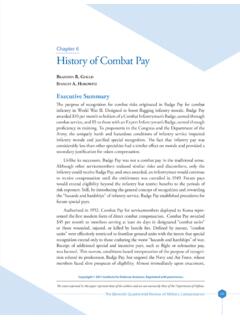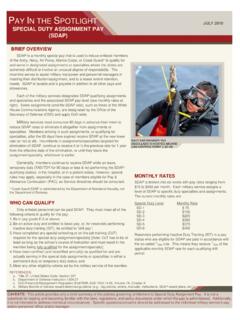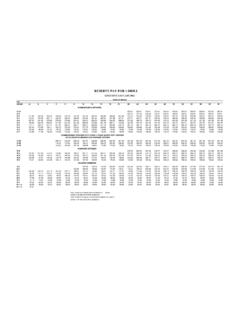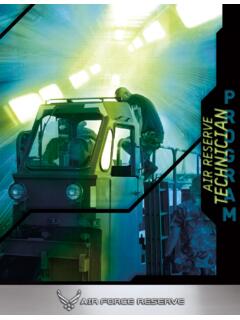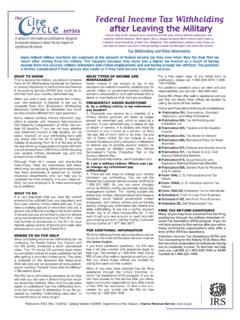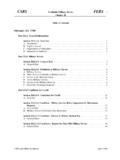Transcription of Chapter 1 Military and Civilian Compensation: How Do They ...
1 3 The Eleventh Quadrennial Review of Military CompensationChapter 1 Military and Civilian Compensation: How Do They Compare?James e. GreferwithDaviD GreGoryerin m. rebhanExecutive summaryBackgroundEvery 4 years, the Department of Defense (DOD) conducts a review of mili-tary compensation. Among its objectives, DOD wants to evaluate whether Military compensation is provided in the amounts and types of payments that ensure that servicemembers are adequately rewarded and that DOD budgets are efficiently and effectively spent. In addition, DOD must compete with private-sector firms and other government organizations for qualified personnel. Compensation is an impor-tant tool for meeting this , a thorough comparison of Military and Civilian compensa-tion will help DOD evaluate and set pay to help meet its strategic objectives.
2 The purpose of this study, one in a series that informs the 11th Quadrennial Review of Military Compensation (QRMC), is to directly compare active duty Military and Civilian and findingsTraditionally, researchers and DOD have compared Regular Military Compensation (RMC) and Civilian wages. In the first section of this study, we continue this tradition by analyzing the trend in RMC over the decade of the 2000s versus the wages of equivalent civilians for enlisted personnel and officers. We also look at 2009 data on how RMC compares with Civilian wages over the first 20 years of service for enlisted, senior enlisted, and 2011 The CNA Corporation. Reprinted with views expressed in this paper represent those of the authors and are not necessarily those of the Department of Eleventh Quadrennial Review of Military Compensation4 Chapter 1In the second section of this study, we estimate the values to servicemembers of two noncash benefits the Military health care benefit and the Federal Insurance Contributions Act (FICA) tax advantage relative to what equivalent civilians receive.
3 Neither of these benefits is part of RMC, but both are received by all service-members. For this reason, understanding the value of these benefits provides greater context to the compensation comparisons presented in the is a useful metric for comparing Military and Civilian compensation. Its strength is in analyzing trends because it is generally not vulnerable to the ups and downs of the national economy (as are continuation bonuses) or to variations and changes in the supply of various skill sets and changes in technology (as, for example, special pays for foreign language skills or hazardous duty are). In addition, its compo-nents are available in some form for all servicemembers. Finally, it has been around in some form since the early 1980s, and so it is likely to be well understood among estimate average RMC for enlisted personnel in 2009 at $50,747 and for officers at $94,735.
4 These amounts corresponded to about the 90th percentile of wages for enlisted equivalent civilians and to about the 83rd percentile of wages for officer equivalent Civilian wages. RMC has trended up over the last decade, both in real value1 and in terms of the corresponding percentile of Civilian In 2001, for example, real average RMC for enlisted personnel was about $42,110, corresponding to the 84th percentile of wages for equivalent civilians. For officers in 2001, real average RMC was about $86,843 and corresponded to the 80th percentile of wages for equivalent civilians. Conversely, we found that real wages have been flat or have even fallen for civilians at all education , why has RMC grown relative to Civilian wages in the decade?
5 The largest components of RMC Basic Pay (BP) and Basic Allowance for Housing (BAH) both grew at rates faster than the growth of Civilian wages by design. By acts of Congress, BP rose at the Employment Cost Index (ECI), which is the Bureau of Labor Statistics (BLS) estimate of national Civilian wage growth, plus 1/2 point from 2000 to 2009. 1. We present all estimates of Military and Civilian compensation throughout this report in real (2009) The corresponding percentile of RMC is the point at which a certain proportion of the Civilian population makes less than that Eleventh Quadrennial Review of Military Compensation5 Military and Civilian CompensationDOD raised real BAH by over 40 percent for enlisted and about 27 percent for officers from 2001 to 2009.
6 This was in response to their goal to reduce service-member out-of-pocket housing expense to zero at the median of home rental prices in each Military housing area. The outcome of these policies has been that RMC grew from the 84th to the 90th percentile of Civilian wages for enlisted and grew from roughly the 79th to the 83rd percentile of Civilian wages for care benefit and FICA tax advantageMost civilians receive some kind of employer health care benefit, as do all service-members. However, of the more than 80 percent of full-time workers who do receive an employer-paid health care benefit, a large majority still pay a substantial share of health insurance premiums and/or cost of medical treatments, whereas servicemem-bers and their families receive all their medical care at no cost.
7 We estimate that the average full-time enlisted equivalent Civilian worker pays between $3,000 and $7,000 per year out of pocket for health insurance and medical care, depending on their family size. Officer equivalent civilians pay between $2,000 and $4,800 per year. Note that the real value of these expenses has grown by 60 to 75 percent over the decade, far faster than the rise in Civilian wages or even the rise in RMC. These are costs that all servicemembers avoid; therefore, they are a valuable portion of their total compensation servicemembers also receive a FICA tax advantage that accrues because BAH and BAS are not subject to this tax. The calculation of this advantage factors in both the FICA tax that is avoided and the value of future Social Security benefits that are foregone.
8 Using actuarial estimates of to percent expected return on the Social Security tax, and 10 to percent personal discount rate for officers and enlisted, respectively, we estimated the expected, discounted net values of the FICA tax advantage to be around $2,042 per year for enlisted and $1,922 per year for numbers do not, by themselves, determine whether Military pay is too high or too low. Other factors, such as recruitment and retention, risk of war, the expected level of personnel tempo, and the desired quality level of Military personnel, must also be considered when determining whether Military pay levels are we do not directly address all of the potential factors here, our method provides a way to contextualize compensation so that decision-makers can decide how much and in what form DOD should pay its Eleventh Quadrennial Review of Military Compensation6 Chapter 1 IntroductionBackgroundTitle 37 of the United States Code ( )
9 Requires that every 4 years the President direct a complete review of the principles and concepts of the compensa-tion system for members of the uniformed The President has designated the Secretary of Defense as the executive agent for the 11th Quadrennial Review of Military Compensation (QRMC).Like past reviews, the 11th QRMC is made up of multiple studies that examine various topics, including pay incentives for critical career fields, hostile fire and combat payments, and benefits available to wounded warriors [1]. CNA s part of the QRMC is to address how active duty Military compensation compares with that of equivalent Military Compensation (RMC)DOD has a long tradition of comparing RMC4 and Civilian compensation.
10 In 1962, the Gorham Commission established the concept of RMC as a rough yardstick to be used in comparing the compensation of members of the uniformed services to the compensation of Civilian -sector employees. While the definitions of the four components of RMC have seen multiple transitions since then, for almost 50 years, DOD and Military researchers have compared RMC with the average wages of equivalent civilians [2, 3, 4, and 5].RMC is often chosen as an appropriate metric for a couple of reasons. First, because it has been around for so many decades, and because it is published annually by DOD [6], it is familiar to most servicemembers something akin to the gross income or salaries of Military , all servicemembers are eligible for all four components of RMC, either in cash or in-kind [4, 5, 6, and 7].
